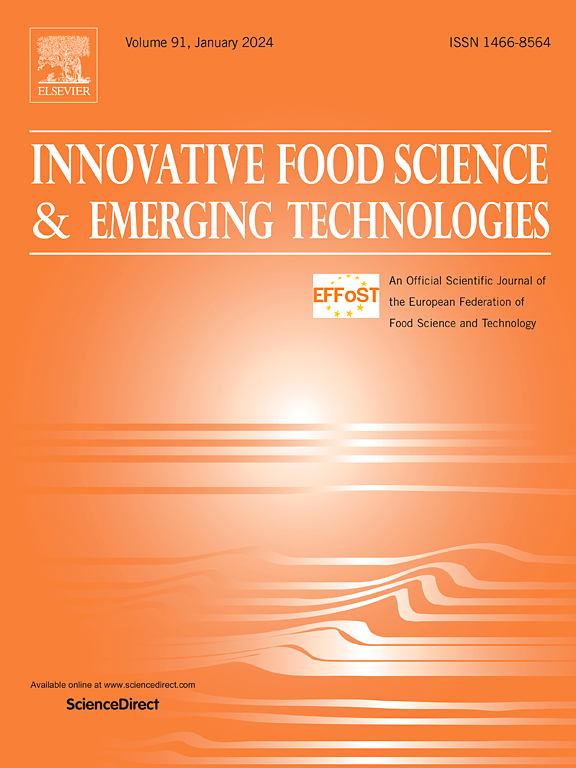在干燥和油炸条件下,通过设计的表面凹槽3d打印豌豆蛋白结构的4D形状变形
IF 6.3
1区 农林科学
Q1 FOOD SCIENCE & TECHNOLOGY
Innovative Food Science & Emerging Technologies
Pub Date : 2025-01-10
DOI:10.1016/j.ifset.2025.103924
引用次数: 0
摘要
形状变形是食品的一种可变形特性,它可以被控制和编程,从而可以创造出独特设计的食品,以实现所需的特性。在此背景下,本研究研究了3d打印豌豆蛋白结构的四维(4D)形状变形行为,重点研究了干燥和油炸条件下凹槽深度和方向的影响。由豌豆分离蛋白(60克)、水(40克)和黄原胶(5克)组成的配方被发现是3D打印的最佳选择,因为它提供了一致挤压所需的流变性能。在45°C、55°C和65°C下的干燥实验表明,更深的凹槽(3 mm)加速了干燥速度,增强了受控形状变形。在65°C时,沟槽样品表现出明显的变形,最大弯曲角度为183±3.14°,曲率为0.187±0.03 μ mm−1。槽的方向进一步影响了变形,其中45°槽方向产生的控制扭转最显著,扭转角为320±3.56°,曲率为0.215±0.09 μ mm−1。孔隙率分析表明,在较高的温度下,孔隙形成增加,特别是在槽状样品中,在65℃下,3 mm槽状样品的孔隙率达到0.62±0.05。核磁共振(NMR)分析显示,沟槽样品的结构变化和水分损失略快。扫描电镜图像显示了沟槽和干燥样品的明显表面变化,这有助于解释它们的变形行为。因此,本研究强调了使用3D食品打印(3DFP)精确设计和打印可编程凹槽几何形状的可能性,从而激活食品材料的后处理4D形状变形。本文章由计算机程序翻译,如有差异,请以英文原文为准。

4D shape morphing in 3D-printed pea protein structures through designed surface grooves under drying and frying conditions
Shape morphing, a deformable property of food, can be controlled and programmable, which allows the creation of uniquely designed foods to achieve desired properties. In this context, the present study investigated the four-dimensional (4D) shape morphing behaviour of 3D-printed pea protein structures, focusing on the influence of groove depth and orientation under drying and frying conditions. A formulation consisting of pea protein isolate (60 g), water (40 g), and xanthan gum (5 g) was found optimal for 3D printing, as it provided the necessary rheological properties for consistent extrusion. Drying experiments at 45 °C, 55 °C, and 65 °C revealed that deeper grooves (3 mm) accelerated drying rates and enhanced controlled shape morphing. At 65 °C, grooved samples exhibited significant morphing, with a maximum bending angle of 183 ± 3.14° and curvature of 0.187 ± 0.03 μ mm−1. The orientation of grooves further influenced morphing, with a 45° groove direction producing the most significant controlled twisting, reaching a twisting angle of 320 ± 3.56° and a curvature of 0.215 ± 0.09 μ mm−1. Porosity analysis showed increased pore formation at higher temperatures, particularly in grooved samples, with porosity reaching 0.62 ± 0.05 for 3 mm grooves at 65 °C. Nuclear Magnetic Resonance (NMR) analysis revealed that grooved samples had slightly faster structural changes and water loss. SEM images demonstrated distinct surface changes in grooved and dried samples, which helped to explain their morphing behaviour. Thus, this research highlights the possibility of using 3D food printing (3DFP) to precisely design and print programmable groove geometries, activating post-processing 4D shape morphing in food materials.
求助全文
通过发布文献求助,成功后即可免费获取论文全文。
去求助
来源期刊
CiteScore
12.00
自引率
6.10%
发文量
259
审稿时长
25 days
期刊介绍:
Innovative Food Science and Emerging Technologies (IFSET) aims to provide the highest quality original contributions and few, mainly upon invitation, reviews on and highly innovative developments in food science and emerging food process technologies. The significance of the results either for the science community or for industrial R&D groups must be specified. Papers submitted must be of highest scientific quality and only those advancing current scientific knowledge and understanding or with technical relevance will be considered.

 求助内容:
求助内容: 应助结果提醒方式:
应助结果提醒方式:


